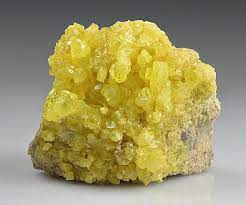Identity.
Sulfur (also spelled sulphur in British English) is a chemical
element; it has symbol S and atomic number 16. It is abundant,
multivalent and nonmetallic. Under normal conditions, sulfur atoms
form cyclic octatomic molecules with the chemical formula S8.
Atomic Structure:
The nucleus consists of 16 protons (red) and 16 neutrons (yellow). 16
electrons (white) bind to the nucleus, successively occupying
available electron shells (rings).
History.
Sulfur was known as brenne stone for "combustible stone" from which
brim-stone is derived. It was known from prehistoric times and thought
to contain hydrogen and oxygen. In 1809, the French chemists
Louis-Joseph Gay-Lussac and Louis-Jacques Thenard proved the elemental
nature of sulfur.
Sulfur, the tenth most abundant element in the universe, has been
known since ancient times. Sometime around 1777, Antoine Lavoisier
convinced the rest of the scientific community that sulfur was an
element. Sulfur is a component of many common minerals, such as
galena (PbS), gypsum (CaSO4·2(H2O), pyrite (FeS2), sphalerite (ZnS
or FeS), cinnabar (HgS), stibnite (Sb2S3), epsomite
(MgSO4·7(H2O)), celestite (SrSO4) and barite (BaSO4). Nearly 25%
of the sulfur produced today is recovered from petroleum refining
operations and as a byproduct of extracting other materials from
sulfur containing ores.
Properties.
Pure sulfur is a tasteless, odourless, brittle solid that is pale
yellow in colour, a poor conductor of electricity, and insoluble in
water. It reacts with all metals except gold and platinum, forming
sulfides; it also forms compounds with several nonmetallic elements.
It is a reactive element that given favorable circumstances combines
with all other elements except gases, gold, and platinum. Sulfur
appears in a number of different allotropic modifications: rhombic,
monoclinic, polymeric, and others.

